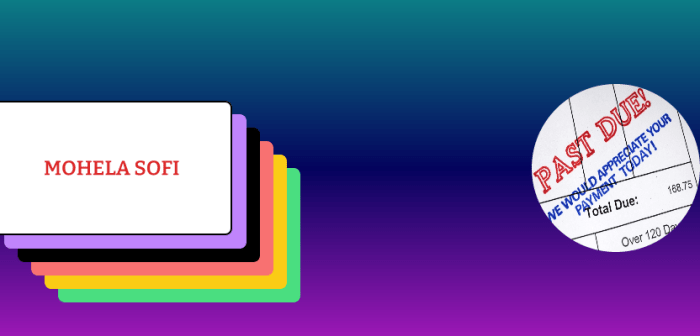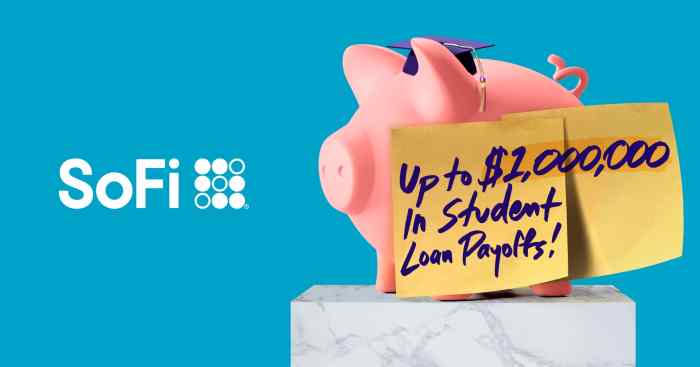
Navigating the complexities of student loan repayment can feel overwhelming, especially when dealing with multiple servicers. This guide delves into the distinct roles of Mohela and SoFi in managing and refinancing federal student loans, offering a clear comparison of their services and highlighting key considerations for borrowers. Understanding the differences between these institutions is crucial for making informed decisions about your repayment strategy and maximizing your financial well-being.
We’ll explore Mohela’s function in servicing federal student loans, detailing its processes and comparing its services to other federal loan servicers. Then, we’ll examine SoFi’s role in student loan refinancing, analyzing its programs, interest rates, and eligibility criteria. A key focus will be comparing the customer experiences, communication methods, and online platforms of both Mohela and SoFi. Finally, we’ll consider the impact of potential student loan forgiveness programs on borrowers utilizing both services, providing practical scenarios and guidance.
Mohela’s Role in Student Loan Servicing

Mohela, the Missouri Higher Education Loan Authority, plays a significant role in the federal student loan system, managing the repayment and servicing of millions of borrowers’ loans. Its history is intertwined with the evolution of federal student loan programs, and its current function is crucial for ensuring the smooth and efficient processing of these loans.
Mohela’s primary function is to act as a loan servicer for the federal government. This involves handling various aspects of the loan lifecycle, from initial disbursement to eventual repayment or loan forgiveness. This complex process requires sophisticated systems and a dedicated team to manage effectively.
Types of Federal Student Loans Serviced by Mohela
Mohela services a wide range of federal student loans. These include Direct Subsidized Loans, Direct Unsubsidized Loans, Direct PLUS Loans (for both graduate and parent borrowers), and Direct Consolidation Loans. The specific types of loans a borrower has will influence their repayment plan options and overall repayment strategy. Understanding the type of loan is crucial for effective repayment planning.
Accessing Mohela Account Information
Accessing your Mohela account information is straightforward. Here’s a step-by-step guide:
- Visit the official Mohela website. The website address should be clearly visible and easily accessible through standard search engines.
- Locate the “Log In” or “Sign In” button, usually prominently displayed on the homepage. This button will typically take you to a secure login portal.
- Enter your username and password. If you’ve forgotten your login credentials, there will usually be options to reset your password or contact customer support for assistance.
- Once logged in, you will have access to your account dashboard. This dashboard will provide a summary of your loan information, including outstanding balances, payment history, and repayment plan details.
- Navigate through the various sections of your account to access specific information. Most servicers provide a clear and intuitive interface to make it easy to find the information you need.
Comparison of Mohela’s Servicing Practices with Other Federal Loan Servicers
While the core functions of all federal student loan servicers are similar, differences exist in customer service responsiveness, online platform usability, and communication practices. Borrowers often report varying experiences depending on their assigned servicer. Direct comparisons between servicers are difficult due to the subjective nature of customer service evaluations and the constantly evolving nature of their online platforms. However, independent reviews and borrower feedback can offer some insights into the relative strengths and weaknesses of different servicers. For instance, some servicers might be praised for their proactive communication, while others might be criticized for slow response times to inquiries. The best way to assess a servicer’s performance is through personal experience and online reviews.
SoFi’s Role in Student Loan Refinancing

SoFi is a major player in the student loan refinancing market, offering a streamlined process and potentially lower interest rates compared to federal loans. Understanding SoFi’s refinancing programs is crucial for borrowers seeking to consolidate and reduce their monthly payments. This section will detail SoFi’s offerings, eligibility requirements, and a comparison with other refinancing options.
SoFi’s Student Loan Refinancing Programs and Eligibility Criteria
SoFi offers refinancing options for both federal and private student loans. To be eligible, borrowers generally need a good credit score (typically above 670), a stable income, and a demonstrable ability to repay the loan. Specific requirements may vary depending on the loan amount, type of loan, and co-borrower status. SoFi assesses each application individually, considering factors beyond just credit score, such as debt-to-income ratio and employment history. Applicants usually need to provide documentation such as pay stubs, tax returns, and student loan statements. SoFi’s online application process is designed to be straightforward, allowing borrowers to quickly check their eligibility and receive a personalized rate quote.
Advantages and Disadvantages of Refinancing Federal Student Loans with SoFi
Refinancing federal student loans with SoFi can offer several advantages, primarily lower interest rates leading to potential savings over the life of the loan. A fixed interest rate can provide predictability in monthly payments, unlike variable rates that can fluctuate. Consolidating multiple loans into a single payment can simplify the repayment process. However, refinancing federal student loans comes with disadvantages. Borrowers lose access to federal protections such as income-driven repayment plans, loan forgiveness programs (like Public Service Loan Forgiveness), and deferment or forbearance options. This means that if financial hardship arises, borrowers have fewer options for managing their payments compared to keeping their federal loans. It’s crucial to carefully weigh these pros and cons before making a decision.
SoFi’s Interest Rates and Repayment Terms
SoFi’s interest rates for student loan refinancing are competitive, but they vary depending on several factors including credit score, loan amount, and repayment term. Generally, borrowers with higher credit scores and lower loan amounts qualify for lower interest rates. SoFi offers a range of repayment terms, typically ranging from 5 to 20 years. Shorter repayment terms result in higher monthly payments but lower overall interest paid, while longer terms result in lower monthly payments but higher overall interest paid. It’s important to compare SoFi’s rates and terms to other lenders before making a decision. Specific rates and terms are available through SoFi’s online application process.
Comparison of SoFi’s Refinancing Options with Other Lenders
| Feature | SoFi | Other Lender A (Example) | Other Lender B (Example) |
|---|---|---|---|
| Interest Rate | Variable, depends on credit score and loan amount (e.g., 5%-10%) | Fixed or Variable, specific rates vary (e.g., 6%-12%) | Fixed, specific rate depends on the loan (e.g., 7%-13%) |
| Repayment Terms | 5-20 years | 5-15 years | 3-10 years |
| Fees | Typically no origination fees | May have origination fees (e.g., 1%-3%) | No origination fees, but may have late payment fees |
| Eligibility Requirements | Good credit score (670+), stable income, debt-to-income ratio | Good credit score (680+), stable income, debt-to-income ratio | Excellent credit score (700+), stable income, low debt-to-income ratio |
Comparing Mohela and SoFi Services

Choosing between Mohela and SoFi for student loan management depends heavily on your individual needs and circumstances. While Mohela primarily services federal student loans, SoFi focuses on refinancing, offering private loan options. Understanding the differences in their services is crucial for making an informed decision.
This section compares and contrasts the customer service, online platforms, communication methods, and repayment options offered by Mohela and SoFi, highlighting the key distinctions to help borrowers make the best choice for their situation.
Customer Service Experiences
Borrower experiences with Mohela and SoFi’s customer service vary significantly. Reports suggest that Mohela’s customer service can be challenging to navigate, with long wait times on phone calls and potentially less responsive online support. Conversely, SoFi is frequently praised for its more accessible and responsive customer service, often featuring shorter wait times and multiple communication channels. However, the quality of service can depend on individual experiences and the complexity of the issue. It’s important to remember that these are generalized observations based on publicly available information and may not reflect every individual’s experience.
Online Platforms and Mobile Applications
Mohela’s online platform and mobile app are generally considered functional but somewhat outdated compared to SoFi’s offerings. SoFi’s platform is often lauded for its user-friendly interface, intuitive design, and comprehensive features, allowing borrowers to easily track payments, manage accounts, and access support resources. Mohela’s platform, while functional, may lack the same level of sophistication and user-friendly design. The mobile app experience mirrors this disparity, with SoFi’s app generally receiving higher ratings for ease of use and functionality.
Communication Methods
Mohela primarily communicates with borrowers via mail, phone, and its online portal. While this covers the basics, some borrowers find the lack of more modern communication options, such as email or in-app messaging, to be inconvenient. SoFi, in contrast, offers a wider range of communication methods, including phone, email, in-app messaging, and secure online messaging. This multifaceted approach allows borrowers to choose the method most convenient for them.
Pros and Cons of Mohela and SoFi
The following list summarizes the key advantages and disadvantages of each service provider concerning communication, accessibility, and repayment options:
- Mohela:
- Pros: Handles federal student loans, established track record.
- Cons: Customer service can be slow and challenging to access; online platform and mobile app may be less user-friendly; limited communication options.
- SoFi:
- Pros: Generally excellent customer service; user-friendly online platform and mobile app; multiple communication options; refinancing options available.
- Cons: Primarily focuses on private loan refinancing; may not be suitable for all borrowers (e.g., those with poor credit).
The Impact of Student Loan Forgiveness Programs
Student loan forgiveness programs, while potentially offering significant financial relief, have complex implications for borrowers depending on their loan servicer and refinancing status. Understanding these impacts is crucial for borrowers to effectively plan for their financial future. The effects vary significantly between loans held directly with the government (and serviced by companies like Mohela) and those refinanced privately (such as with SoFi).
Potential forgiveness programs generally target federal student loans. Therefore, the impact on borrowers differs greatly depending on whether their loans remain federal or have been refinanced into private loans.
Impact on Mohela Borrowers
Borrowers with federal student loans serviced by Mohela could experience direct and immediate benefits from loan forgiveness programs. If a program forgives a portion or all of their eligible federal student loan debt, Mohela would be responsible for processing the forgiveness, resulting in a reduction or elimination of their outstanding balance. The specific impact depends on the terms of the forgiveness program, including the eligibility criteria, the amount of forgiveness, and any associated tax implications. For example, the Public Service Loan Forgiveness (PSLF) program has specific requirements for employment and loan type. Meeting those requirements can lead to complete forgiveness after 120 qualifying payments.
Impact on SoFi Borrowers
Borrowers who have refinanced their federal student loans with SoFi will generally not be eligible for federal student loan forgiveness programs. Refinancing converts federal loans into private loans, removing them from the purview of federal forgiveness initiatives. This is because SoFi’s refinancing process replaces the original federal loan with a new private loan, governed by different terms and conditions. Therefore, any potential forgiveness opportunities associated with the original federal loans are lost upon refinancing.
Scenario: Partial Loan Forgiveness
Consider a borrower with $50,000 in federal student loans serviced by Mohela and an additional $20,000 refinanced with SoFi. If a hypothetical forgiveness program forgives 20% of eligible federal student loan debt, the borrower would see a reduction of $10,000 ($50,000 x 0.20) on their Mohela loans. Their SoFi loan balance, however, would remain unchanged at $20,000. This results in a net reduction of $10,000 in their total student loan debt, leaving them with a remaining balance of $50,000.
Potential student loan forgiveness programs offer significant benefits to borrowers with federal loans serviced by companies like Mohela, potentially leading to substantial debt reduction or elimination. However, borrowers who have refinanced their federal loans with private lenders such as SoFi generally lose eligibility for these programs. The financial impact of any forgiveness program will depend on the specific terms of the program and the borrower’s individual loan portfolio.
Navigating the Transfer Process Between Servicers
Transferring federal student loans between servicers, such as from Mohela to another lender like SoFi (for refinancing), can seem daunting, but understanding the process and potential hurdles can make it smoother. This section details the steps involved and potential challenges borrowers might face.
The Loan Transfer Process from Mohela to Another Servicer
The transfer of federal student loans from one servicer to another is typically initiated by the Department of Education (ED). Borrowers usually don’t directly request a transfer unless they are refinancing with a private lender like SoFi. If the ED assigns your loans to a new servicer, you will receive notification from both your current (Mohela) and new servicer. This notification will include details about the transfer date and the new servicer’s contact information. The process usually involves a period of time where both servicers are involved, and during this period, borrowers should continue making payments to their existing servicer. Failure to make payments during the transition period could negatively impact your credit score.
Potential Challenges During the Transfer Process
Several challenges can arise during a loan transfer. One common issue is delayed communication. You might experience delays in receiving official notification from either Mohela or the new servicer. Another potential problem is inaccurate information transfer. Sometimes, data discrepancies occur during the transfer, leading to incorrect account details or payment history. This can cause issues with payment processing and reporting. Finally, borrowers might encounter difficulties accessing their account online during the transition period, as the new servicer might require time to update their systems.
Updating Contact Information with Mohela and SoFi
Keeping your contact information updated is crucial for smooth loan servicing. To update your information with Mohela, you’ll typically log into your Mohela account online. Look for a section labeled “Profile,” “Contact Information,” or something similar. Update your address, phone number, and email address, confirming the changes. Similarly, if refinancing with SoFi, you’ll need to update your contact information through your SoFi account. SoFi’s website usually has clear instructions on how to modify your contact details. It is recommended to verify your information with both servicers after updating.
Visual Representation of the Loan Transfer Workflow
Imagine a flowchart. The process begins with the “Loan Assignment” box, representing the Department of Education assigning your loans. An arrow leads to the “Notification to Borrower” box, where you receive notification from both Mohela and the new servicer. This branches into two parallel paths: “Mohela Account Updates” and “New Servicer Account Setup.” Each path has a “Potential Delays” box representing possible delays in communication or data transfer. The paths converge at a “Loan Transfer Complete” box. Key decision points include confirming your contact information with both servicers and ensuring accurate payment processing during the transition. Potential delays are highlighted at each stage, emphasizing the importance of proactive communication and patience during this process.
Ultimate Conclusion
Ultimately, the choice between managing your federal student loans directly through Mohela or refinancing with SoFi depends on your individual financial circumstances and long-term goals. Careful consideration of interest rates, repayment terms, and the potential impact of future forgiveness programs is essential. This guide provides a framework for understanding the nuances of each service provider, empowering you to make informed decisions that best suit your needs and contribute to your financial success.
Commonly Asked Questions
What happens if I miss a payment with Mohela?
Missing a payment with Mohela will likely result in late fees and negatively impact your credit score. Contact Mohela immediately to explore options like forbearance or deferment.
Can I refinance my federal student loans with SoFi if I have a cosigner?
SoFi’s refinancing options may accommodate cosigners, but eligibility depends on several factors including credit score, income, and debt-to-income ratio. Check SoFi’s website for specific requirements.
What types of federal student loans does Mohela service?
Mohela services various federal student loans including Direct Subsidized Loans, Direct Unsubsidized Loans, Direct PLUS Loans, and Direct Consolidation Loans. Check your loan documents for specifics.
Does SoFi offer any hardship programs?
SoFi may offer hardship programs, but the specifics vary. Review SoFi’s website for current information and eligibility criteria. These programs may involve temporary reduced payments or other assistance.
